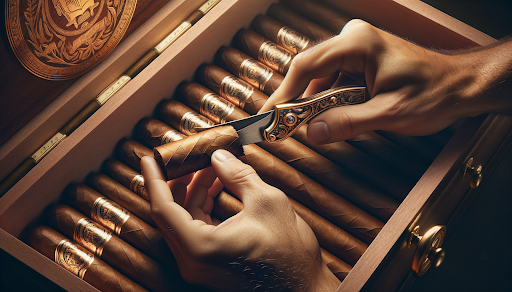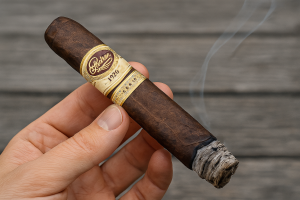How to Cut a Cigar Without a Cutter: Techniques for the Perfect Draw and Flavor Experience

When it comes to enjoying a fine cigar, the cut is a critical part of the experience. An improper cut can lead to a poor draw or uneven burning, diminishing the enjoyment that a well-crafted cigar offers.
While cigar cutters are the preferred tools for many enthusiasts, there may come a time when you find yourself without one. Fortunately, there are several methods learn how to cut a cigar without a traditional cutter.
This guide will explore these techniques, providing you with the knowledge needed to maintain the quality of your cigar experience.
Best Techniques to Cut a Cigar Without a Cutter
You can cut a cigar without a cutter by using your teeth, a sharp object, a coin, a lighter flame, or rolling it against a hard surface, with each method offering unique advantages and drawbacks.
Using Your Teeth:
- Method: Use your front teeth to bite off the cap of the cigar gently, positioning your teeth just above the shoulder where the rounded part transitions into the straight section.
- Pros: This method is quick and requires no additional tools.
- Cons: There's a risk of damaging the wrapper and creating a jagged cut, which may affect the draw.
Utilizing a Sharp Object:
- Options: Look for a sharp knife, a pair of scissors, or even a pen-knife.
- Method: Place the blade against the cap of the cigar, applying light pressure. Rotate the cigar as you slice to create a clean cut.
- Pros: This method can offer precision if handled carefully.
- Cons: There is a risk of cutting too deep or causing the wrapper to tear.
Slicing with a Coin:
- Method: Hold a coin (preferably a quarter or any thick coin) against the cap and rotate the cigar, pressing down gently until it breaks the wrapper.
- Pros: This method can yield a decent cut and is readily available.
- Cons: The cut may not be as precise as other methods.
Using a Lighter Flame:
- Method: Carefully use a flame from a lighter to singe the cap of the cigar, causing the leaf to loosen. Once it gapes open, gently pull it away.
- Pros: This helps to open up the cap without a hard cut.
- Cons: The flavor and aroma could be negatively impacted due to heat.
Rolling the Cigar Against a Hard Surface:
- Method: Gently roll the cigar against a hard surface like a tabletop, applying light pressure to crack the cap, being cautious not to roll too hard to avoid crushing the tobacco.
- Pros: This can create a natural break in the wrapper.
- Cons: Not all cigars will respond well, risking an uneven cut.
Additional Tips for a Successful Cut
- Know Your Cigar: Different cigars have varying cap styles; some may have a rounded cap suitable for biting, while others may be flat.
- Practice Caution: When using sharp objects, always direct the blade away from your body and be mindful of your grip.
- Measure Your Cut: If possible, visualize a clean line before cutting to ensure you don’t take off too much tobacco.
- Check the Draw: After you cut the cigar, take a few gentle puffs to ensure airflow is unobstructed. If it feels tight, consider recutting or making adjustments.

Avoiding Common Mistakes When Cutting Without a Cutter
While improvising without a cigar cutter, there are some common pitfalls to avoid to ensure you maintain the integrity and quality of your cigar. Here’s what to look out for:
- Applying Excessive Pressure: Using too much force when biting or rolling the cigar can crush the tobacco, leading to a tight draw and uneven burn. For instance, with a delicate cigar like the Davidoff Signature 2000, excessive pressure can damage its finely crafted structure.
- Cutting Too Deep: Removing more than just the cap can cause the wrapper to unravel. This is particularly detrimental to cigars with intricate wrappers, such as the Cohiba Siglo VI, where the wrapper's integrity is crucial for flavor and burn consistency.
- Overheating with Flame: Using a lighter to open the cap can introduce unwanted flavors if not done carefully. Premium cigars like the Montecristo No. 2 are crafted for specific flavor profiles that excessive heat can alter.
- Skipping the Draw Check: After improvising a cut, always test the draw. A cigar like the Romeo y Julieta Churchill should offer a smooth draw; if it's too tight, consider adjusting your cut.
- Choosing the Wrong Method for the Cigar Type: Different cigars have varying cap styles. For example, the Partagas Serie D No. 4 has a rounded cap suitable for biting, while the H. Upmann Magnum 50 with a flat cap may require a more precise cutting method.
By avoiding these common mistakes, you’ll be better prepared to cut your cigar without a traditional cutter and enjoy a well-preserved, flavorful smoke.
Practical Insights for Cigar Enjoyment
Understanding how to cut a cigar without a dedicated cutter can be an invaluable skill for any cigar enthusiast.
Although having the right tools on hand is always the ideal scenario, there are occasions when you may find yourself without a cutter, whether due to travel or an unexpected situation.
In such moments, improvisation becomes essential, and knowing alternative methods can ensure that you still enjoy a satisfying smoking experience.
Key Takeaways:
- Assess the type of cigar you’re dealing with for the best cutting method.
- Loose caps or rounded ends may lend themselves better to biting, while flat caps may need precise cutting tools.
- Maintain a steady hand and approach makeshift methods with care to preserve the cigar's integrity.
With these techniques in mind, you’re now equipped to enjoy your cigars even in the absence of a cutter, ensuring you can indulge in a rich experience anytime, anywhere.















